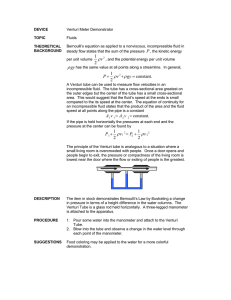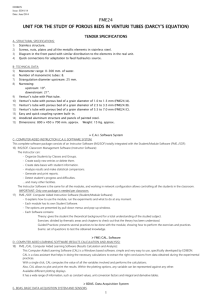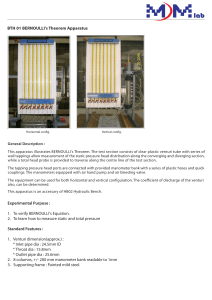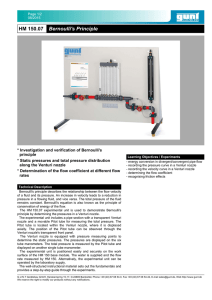S c h o o l o f ... M e c h a t r o n i...
advertisement
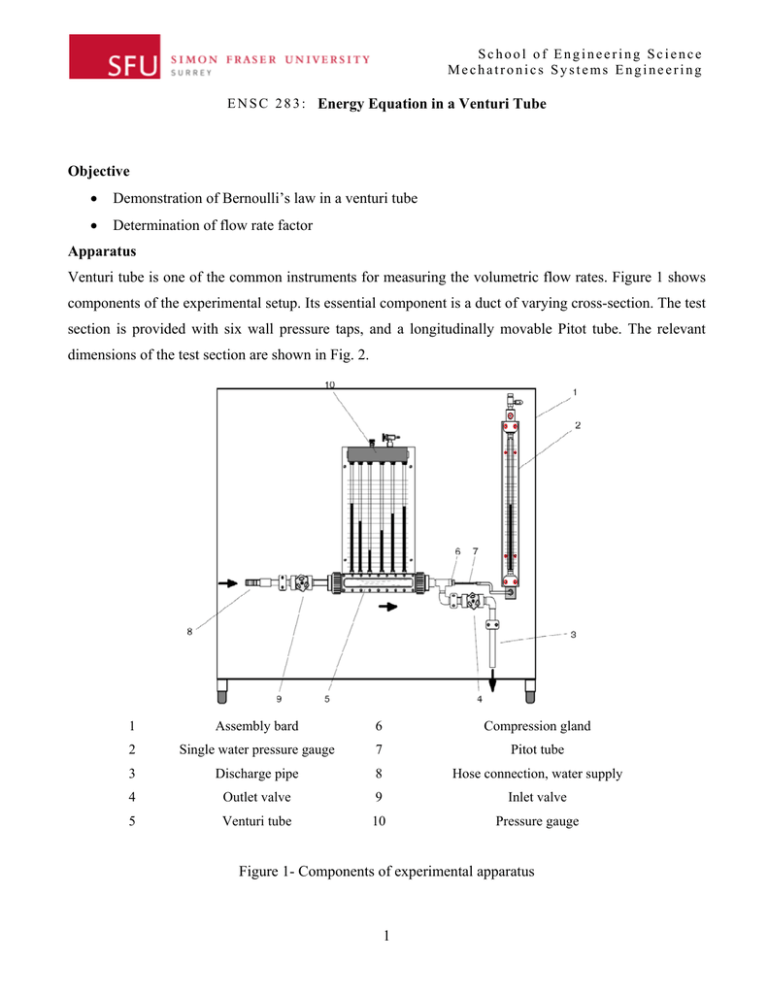
School of Engineering Science Mechatronics Systems Engineering E N S C 2 8 3 : Energy Equation in a Venturi Tube Objective • Demonstration of Bernoulli’s law in a venturi tube • Determination of flow rate factor Apparatus Venturi tube is one of the common instruments for measuring the volumetric flow rates. Figure 1 shows components of the experimental setup. Its essential component is a duct of varying cross-section. The test section is provided with six wall pressure taps, and a longitudinally movable Pitot tube. The relevant dimensions of the test section are shown in Fig. 2. 1 Assembly bard 6 Compression gland 2 Single water pressure gauge 7 Pitot tube 3 Discharge pipe 8 Hose connection, water supply 4 Outlet valve 9 Inlet valve 5 Venturi tube 10 Pressure gauge Figure 1- Components of experimental apparatus 1 School of Engineering Science Mechatronics Systems Engineering E N S C 2 8 3 : Energy Equation in a Venturi Tube Figure 2- Cross-sections of the venturi tube. Flow of water through the test section is provided by the pump of the Hydraulics Bench, and the discharge is measured by accumulating flow over a period of time in the volumetric metering tank of the hydraulic bench. Theory The total energy of a flow is related to static pressure, , velocity squared, , and elevation, . When the flow is steady, frictionless and incompressible, and no work or heat transfer occurs, the total energy along a streamline is constant and is described by the Bernoulli equation: (1) 2 where is the gravitational acceleration. The terms in the Bernoulli equation may also be expressed as energies per unit weight, or ‘heads’. The total head corresponds to the height to which liquid would rise in a Pitot tube attached to the flow, and is therefore a measure of the total energy head, .: (2) . The piezometric head, ., 2 measured by a piezometer, includes only the elevation and pressure heads of the flow: (3) . Using the difference between pizometric head and total energy head in each location one can calculate the velocity in the cross-section: 2 School of Engineering Science Mechatronics Systems Engineering E N S C 2 8 3 : Energy Equation in a Venturi Tube 2 (4) . . The velocity can also be calculated using continuity equation and the volumetric flow rate that is measured during the experiment. A venturi tube can be used for flow rate measurements. In comparison with orifice or nozzle, there is a smaller pressure loss during measurements of flow rate. The pressure loss, ∆ , between largest and smallest diameter of the tube is used as a measure for the flow rate: √∆ The flow rate factor (5) is generally made available for the user by the manufacturer of a venturi tube. If the flow rate factor is unknown, it can be determined from the pressure loss ∆ : (6) √∆ Procedure • Open the inlet and outlet valves. • Switch on the pump and slowly open the main cock. • Open the vent valves on the water pressure gauges. • Carefully close the outlet cock until the pressure gauges are flushed. • By simultaneously setting the inlet and outlet cocks, regulate water level in the pressure gauges such that neither upper nor lower range limit is overshot or undershot Record pressures at all measurement points. Then move overall pressure probe to corresponding measurement level and note down the total pressure. • Determine the volumetric flow rate. To do so, use stopwatch to establish time required for raising the level in the tank from 20 to 30 litres. Plot measured and calculated values of velocities versus length of the venturi tube. Also, plot pizometric, total, and velocity heads versus the length of the venturi tube. Using the measured values, calculate flow rate factor of the venturi tube. 3 School of Engineering Science Mechatronics Systems Engineering E N S C 2 8 3 : Energy Equation in a Venturi Tube Discussion 1) Why does the energy grade line slope downward in the direction of flow? What are the assumptions that lead to a horizontal total energy line? 2) Is it possible for the pressure to increase in the direction of uniform (i.e., constricted) pipe flow? 3) How can flow separation be avoided? 4) What is the difference between separation and cavitation? 4
